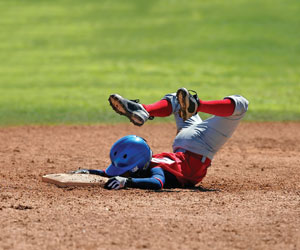If you played sports as a child, you may remember the glory of making that very first goal or home run, and how great it felt to be a part of a team — having fun, playing outside and not caring if you won or lost.
 But are sports really as carefree as we remember?
But are sports really as carefree as we remember?
Over the last decade, doctors, trainers and physical therapists have been asking the question: Just how hard are children pushing themselves? And are the kids doing the pushing, or are parents and coaches encouraging them to succeed — sometimes to the point of injury?
According to the latest statistics from the National SAFE KIDS Campaign and the American Academy of Pediatrics, about 30 million children and teens participate in some form of organized sports. Of those, more than 3.5 million children ages 14 and younger get hurt, receiving medical treatment for sports injuries.
Of those 3.5 million, the SAFE KIDS Campaign finds that half of those sports injuries could have been prevented through protective equipment, proper conditioning, adequate hydration or close supervision. And, according to the National Youth Sports Safety Foundation, traumatic brain injury is the leading killer and cause of disability in children and young adults.
University of Washington (UW) student Jenna Anderson once hoped to go to college on a soccer scholarship. This dream didn’t seem far off for Anderson, a high school varsity soccer player who had been playing soccer year-round since she was in second grade. When she wasn’t playing on the high school team, she played with two other teams, some nights going to two different practices.
“I would come home exhausted; I barely had time to finish my homework,” Anderson says. By the middle of her junior year, Anderson had torn all the ligaments in her ankles, and was starting to complain of back problems. Her doctor told her she’d fractured the last vertebrae in her spine and recommended she stop playing.
Instead of playing soccer, she spent her entire senior year visiting a chiropractor every other day. Now, at 24, Anderson still has back problems, though she has not played soccer since high school. “I hate that I have to worry about this at my age, and worry even more about what I will feel like in my 30s or 40s,” she says. Anderson still has fond memories of playing soccer as a kid, but if she could go back, she says that she’d “take it a little easier.”
Seattle Children’s and UW Sports Medicine physician Brian Krabak says a little moderation is a good idea. “Children who play multiple sports year-round never take breaks and wear down their bodies due to lack of rest,” Krabak says. “Even pro athletes take off days in between games or tournaments, and rest for months to prepare for the season. Our children are not adult athletes; their bodies work differently. They need at least one or two days a week to rest.”
Prevention is key
With more studies focusing on children’s sports injuries, Krabak explains that we’re learning more about injury prevention and appropriate sports training levels for different age groups. “Prevention is key,” Krabak says. “Sports need to be fun, enjoyable for everyone, and thought of as life fitness and keeping your body healthy, rather than just competing.”
Sammamish Little League coach Bob Bocko agrees. “Parents need to remember that 99 percent of all kids playing youth sports will never play collegiate or professional ball. It is important for them to do their best while having fun and be able to forget about the game as soon as it’s over.”
Krabak normally sees the most sports injuries from football, soccer and basketball. And besides the usual sprains and strains, he treats many youth patients for serious knee injuries, such as anterior cruciate ligament (ACL) tears, and concussions due to playing sports.
According to studies by Santa Monica Orthopaedic and Sports Medicine Group in California, female athletes nationwide are up to eight times more likely to suffer from serious knee injuries than their male counterparts, because of the way they land with their knees while jumping. The group has devised a prevention plan called the PEP Program, which structures 15 minutes of stretching and strengthening routines to be done two to three times per week to help prevent ACL problems. Luckily, Krabak notes, most muscle/skeletal injuries (including ACL tears) are minor and can be easily treated with proper care.
As for concussions, many parents and coaches have worried in the past about children being put back in the game without being checked out. On March 31, 2009, Washington state approved a bill known as the Zackery Lystedt law, which requires parents and young athletes to sign a concussion and head-injury form, and that any child with a potential concussion must be evaluated by an expert and have written clearance before returning to the sport.
That law was named after a student football player who tumbled headfirst into the ground during a game when he was 13 years old. Lystedt was sidelined for only 15 minutes before returning to the game. Now 16, Lystedt, who had suffered a concussion, is in a wheelchair and is regaining strength in his left leg and foot. This is just one case of many; the National Centers for Disease Control and Prevention reports that 3.8 million sports- and recreation-related concussions occur every year.
According to Krabak, although, 70 percent to 80 percent of concussions or mild traumatic brain injuries will get better within a week, parents should watch for signs of a concussion if they think their child has been injured while playing a sport. Signs to watch for, says Krabak, include headaches, inability to concentrate, decreased school performance and altered sleeping patterns. If you suspect your child has sustained a concussion, contact your child’s doctor.
More information can be found at the PEP Program website.
Jen Betterley is a Seattle freelance writer who works with children by day, writes by night, and equally loves doing both.
INJURY PREVENTION
- Make sure your child’s sports equipment fits correctly; school equipment may not always fit properly.
- Communicate with your child about how he is doing and feeling.
- Make sure your child has the appropriate sports training for her level and age, including proper technique, strengthening and conditioning.
- Allow your child to fully rest for one or two days a week.
Source: Dr. Brian Krabak











